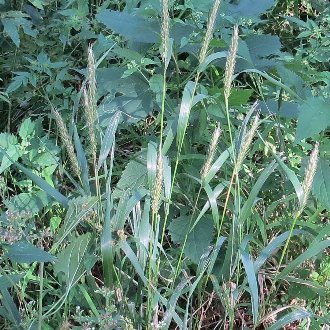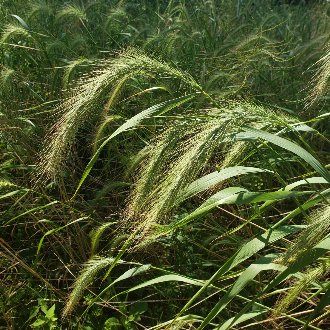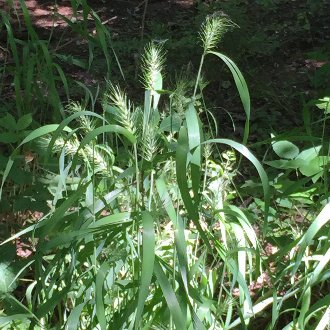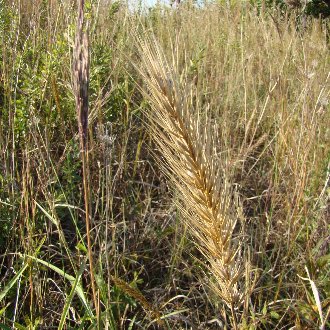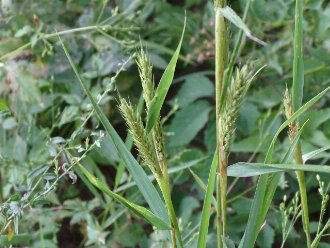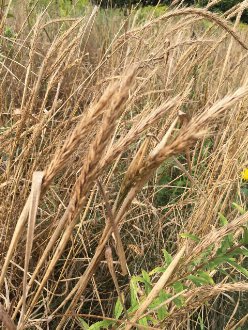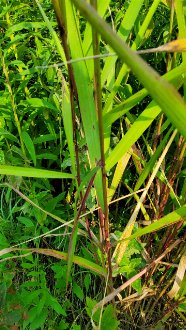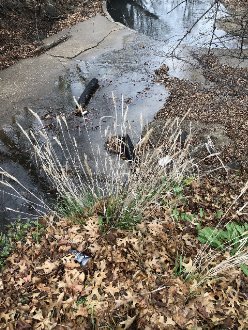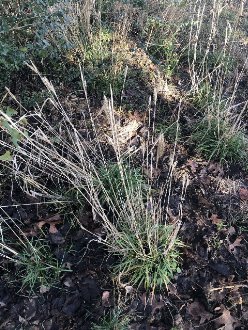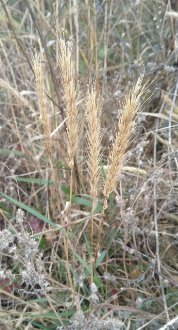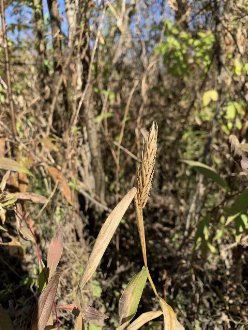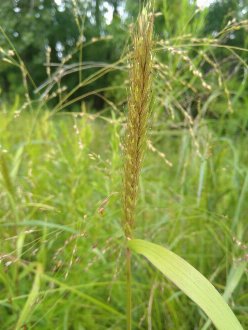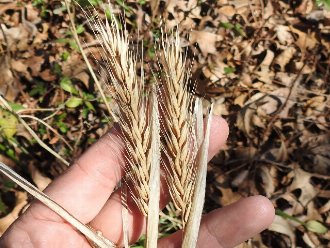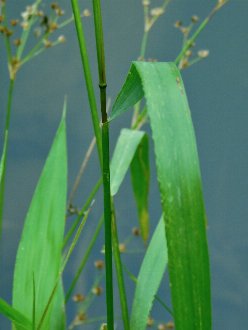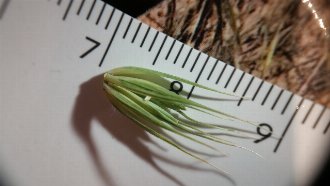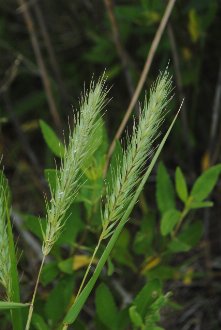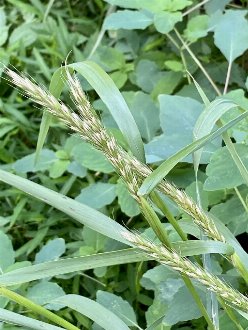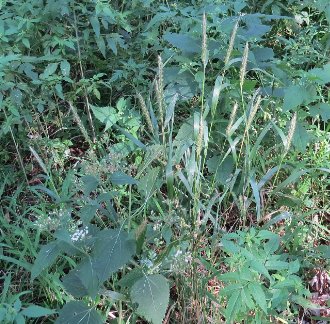Virginia Wildrye (Elymus virginicus L.)
This species has been the subject of considerable taxonomic flux. Many sources treat southeastern wildrye (Elymus glabriflorus) and early wildrye (Elymus macgregorii) (which was only described in 2000) as a variety or subspecies of this one. As such, some keys will identify individuals we would consider to belong to that species as this one instead, and many articles may discuss characteristics specific to those populations under the name of this species. There are also some sources that recognize populations that we include in this species as separate species. POWO lumps E. glabriflorus in with this species, and recognizes no subtaxa. Our classification scheme most closely follows that used by FNA, BONAP, and iNaturalist, which seem to be in agreement.
↑Summary
A perennial, cool-season bunchgrass found in moist, sunny to partly-sunny areas, native to almost all but the westernmost parts of North America.
↑Range - Expand
| Legend | Color |
| Native | |
| Native or Not Present |
This tentative map is based on our own research. It may have limited data on Canada and/or Mexico, and there is some subjectivity in our assignment of plants as introduced vs. expanded. Read more in this blog post.
Although this plant occurs somewhere in each of these regions, it may only occur in a small part of some or all of them.
↑Similar Plants
↑Habitat
This species is one of the most widespread of the Elymus species and is abundant in much of its range. It is found in openings in deciduous woodlands, especially in floodplains and bottomlands, moist prairies, swamp margins, and locally-moist sites in savannas, bluffs, and other open upland habitats. Also found in coastal habitats including brackish and salt marshes, and wet areas along beaches. Sometimes found in anthropogenic habitats including along roadsides and railroads, pastureland, fallow fields, and small woodland fragments.
Found in full sun to light shade, but usually restricted to moister soil conditions, especially on sunnier sites. Tolerates some amount of clay in soil, but prefers rich, loamy soil. Tolerates greater salinity than most Elymus species, and in the northern half of the east-coast, is the only Elymus species found in these more saline habitats. Prefers some amount of disturbance but intolerant of heavy disturbance such as regular mowing.
Flora of North America breaks this species into four different varieties which have different habitat preferences. Var. halophilus is restricted to coastal brackish marshes along the northern portions of the East Coast. Var. jejunus is more common in the west, present but uncommon in the northeast, and absent from the southeast, prefers higher soil pH, and ranges into drier conditions. Var. intermedius is most common on base-rich, rocky, gravelly, or sandy soils along banks of larger streams in the central and southern Great Plains and central Ohio and Mississippi valleys, into the northeast as well. Var. virginicus is widespread and common in the entire eastern region, and becomes less common moving west, intergrading with var. jejunus. These varieties are not universally recognized; POWO does not recognize any sub-taxa of this species.
This species frequently overlaps with other Elymus species in the same habitat. Relative to early wildrye (Elymus macgregorii) it is less restricted to calcium-rich soils and more tolerant of full sun. Relative to riverbank wildrye (Elymus riparius) it is less tolerance of flooding, and ranges into drier, sunnier habitats farther from streams. Relative to silky wild rye (Elymus villosus) it is more demanding of moisture, ranges farther south, and less tolerant of rocky soils. Relative to Canada wildrye (Elymus canadensis) it prefers less-disturbed, moister sites, and is more tolerant of acidic soils. Relative to southeastern wildrye (Elymus glabriflorus), it is more restricted to moist sites. Relative to eastern bottlebrush grass (Elymus hystrix) it is less tolerant of shade and prefers moister sites.
↑Life Cycle
This species is a perennial, cool-season bunchgrass.
Plants germinate in spring and rarely flower in their first year, instead growing only a few narrow blades during their first growing season.
Growth primarily occurs during late winter through spring. Second-year and older plants will grow upright stems with evenly-spaced blades, which will often flop over in the absence of support. Growth slows during the hotter weather. This species flowers and sets seed slightly later than some Elymus species, with seed typically maturing in late summer. By this time, the plant's foliage has typically slowed, and in drier conditions, much of it will have dried up by the time the seed matures.
Plants experience a second flush of growth in the fall, which stays lower to the ground. In the warmer parts of its range and in warm winters, plants will remain lush and green all winter long, but in colder regions, or in colder, drier winters, they go dormant.
On favorable sites, this species reproduces vegetatively at the base by tillering, forming large clumps that become more vigorous so long as good conditions persist. Vigorous clumps will produce numerous upright stems. It does not spread long distances vegetatively, instead relying on seeds to this end.
Plants usually compete well against ground-level vegetation. They can die if they become too shaded by trees or shrubs, and, especially on low sites, they can be killed by prolonged flooding. Plants can also be killed by heavy grazing by mammals (wild or livestock), or regular mowing.
↑Faunal Associations
Early in the season, livestock including horses and cattle will browse the foliage, but they avoid it once the awned seedheads develop. Canada geese will also sometimes browse the foliage. The seeds are eaten by mice, including the native white-footed mouse (Peromyscus leucopus) and eastern deer mouse (Peromyscus maniculatus), and the introduced house mouse (Mus musculus), and ducks including the mallard (Anas platyrhynchos), and the lesser scaup (Aythya affinis).
This grass supports a large amount of insect biodiversity.
The larvae of several lepidoptera eat this species. The larvae of the moth Elachista leucofrons mine the leaves of this and other Elymus species from February to mid-April, and tend not to reach the bases of leaves. The glassy cutworm (Apamea devastator) eats the roots and basal stems of this and many other grasses, predominately in the northeast. The phragmites wainscot (Leucania phragmitidicola), of which not much is known, eats this species as well as other grasses and sedges, and the false wainscot (Leucania pseudargyria) eats this species as well as other grasses and cattails. The bronzed cutworm (Nephelodes minians), a generalist best known for attacking numerous commercial crops, also feeds on this species.
At least three leafhoppers eat this plant, including the shovel-nosed leafhopper (Dorycephalus platyrhynchus), Elymana acuma, and Sorhoanus orientalis. At least three aphids also feed on this plant, Carolinaia howardii, Carolinaia rhois, which feeds on sumac (Rhus) as a primary host and grasses as a secondary host, and the bristly olive grass aphid (Sipha elegans), a introduced aphid which feeds on many grasses and is considered a pest of cultivated crops.
↑Related Plants
This species is closely related to most of the other Elymus species with which it overlaps in range. Its closest relatives are likely southeastern wildrye (Elymus glabriflorus) and early wildrye (Elymus macgregorii), followed by eastern bottlebrush grass (Elymus hystrix). Genetic analysis suggests it is also closely related to canada wildrye (Elymus canadensis) and silky wild rye (Elymus villosus).
Most of the other Elymus species in North America are native; the only widespread introduced one is quackgrass (Elymus repens), which is visually quite distinct from this species, and is invasive.
The broader Triticeae tribe includes numerous other species, both native and introduced, and includes the three cultivated grains wheat, barley, and rye, which are also introduced. Some classifications place it into the sub-tribe Hordeinae, which does not include all genera in Triticeae.
↑Links & External Resources
• Elymus virginicus (Virginia Wild Rye) | Illinois Wildflowers (About This Site)
• Elymus virginicus (Virginia wildrye) | USDA PLANTS Database (About This Site)
• Elymus virginicus | Go Botany (About This Site)
• Virginia Wildrye | iNaturalist (About This Site)
• Elymus virginicus (Virginia Wild Rye) | Missouri Botanical Garden Plant Finder (About This Site)
• Elymus virginicus | Biota of North America Project (BONAP) (About This Site)
• Elymus virginicus | NatureServe Explorer (About This Site)
• Elymus virginicus | Flora of North America (About This Site)
• Elymus virginicus† | Missouri Plants (About This Site)
• Virginia Wildrye | Maryland Biodiversity Project (About This Site)
• Saltmarsh Virginia Wildrye (halophilus) | Maryland Biodiversity Project (About This Site)
• Intermediate Virginia Wildrye (intermedius) | Maryland Biodiversity Project (About This Site)
• Virginia Wildrye (virginicus) | Maryland Biodiversity Project (About This Site)
• Elymus virginicus L. var. halophilus (Bickn.) Wieg. (Virginia Wild Rye) | Digital Atlas of the Virginia Flora (About This Site)
• Elymus virginicus L. var. virginicus (Virginia Wild Rye) | Digital Atlas of the Virginia Flora (About This Site)
• Elymus virginicus L. var. intermedius (Vasey ex . Gray) Bush (Virginia Wild Rye) | Digital Atlas of the Virginia Flora (About This Site)
• Elymus virginicus L. var. jejunus (Ramalay) Bush (Virginia Wild Rye) | Digital Atlas of the Virginia Flora (About This Site)
Different Taxonomic Treatments
† Each of these links refer only to part of the populations covered by this page.



